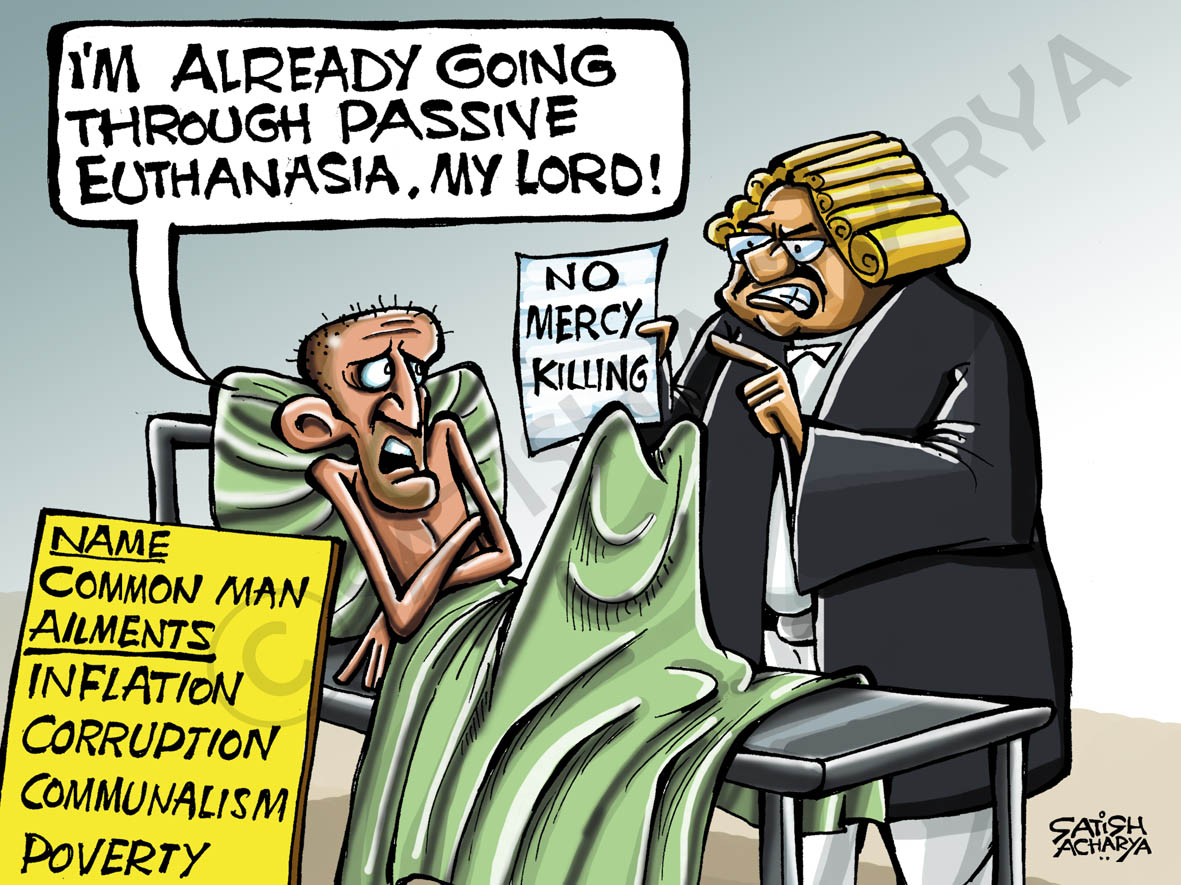
DEATH comes as the end. Anyone born in this world must perforce die, despite the level of medical knowledge and skill at present. And when that medical knowledge is quite certain that a person’s sickness is not going to be cured, in other words she/he is terminally ill, would it not be merciful to allow the person to die? Would not euthanasia- or mercy killing as it has come to be termed- be acceptable to the suffering patient as well as to those who are close to her or him? As the Supreme Court opens up the euthanasia debate and asks for opinion from states and UTs, the house of discussion is open for us also.
Painless death, which is what euthanasia basically means, is something that each of us desires even if we are not afraid of that final annihilation. Visions of being bed- ridden, suffering increasing and incurable pain, causing trouble and grief to those whom one holds dear, above all, being dependent on others with no hope of recovery- such visions do disturb the imagination of even the most robust in health and even the most optimistic among us, at least fleetingly. At such moments, the idea of an easy death is certainly attractive.
 The issue of euthanasia involves two aspects: passive and active. Passive euthanasia would be the right to refuse medical treatment which merely prolongs life technically but holds no possibility of a cure or a resumption of normal activity. It is something that many people have done.
The issue of euthanasia involves two aspects: passive and active. Passive euthanasia would be the right to refuse medical treatment which merely prolongs life technically but holds no possibility of a cure or a resumption of normal activity. It is something that many people have done.
It is when we come to the ‘active’ aspect of euthanasia that ethical dilemmas come to the fore. For it involves not merely a refusal to be medicated but a conscious and deliberate decision to end one’s life in case of terminal illness, and beyond that the right of doctors to be protected from prosecution if they accede to a patient’s request for mercy killing.
‘Active’ euthanasia, in its essence comes down to legalized suicide or legalized murder or abatement to suicide. There is a deep rooted belief in most people that life is a god given gift and it is presumptuous on the part of a human being to throw it away. And if the patient is in coma without having expressed any idea on the subject, who is to decide on actively terminating the person’s life? The possibility of greedy and unscrupulous relatives colluding with an equally unscrupulous doctor to kill a patient, from whose death, they stand to gain, is a real danger. Even if a doctor is sincere and honest, the dilemma will remain whether the decision to terminate life was right or wrong at a deep moral level, because a doctor’s duty is surely to prolong life and not assist in shortening it.
What if after deciding to allow euthanasia and being administered the lethal drug, hovering between life and death, a patient wants to reverse his or her decision and does not want to die as yet? Even those making a ‘living will’ to die may yet feel like changing their mind towards the end, but drift into coma before expressing their changed view-point. What then? Who can decide correctly for such a patient? The diameter of complications can be huge.

Any law on euthanasia should, of course, have clear safeguards to preclude any possibility of treasonous elements exploiting the situation. The prime decision should come from the person concerned, and that too after long and deep thought. There is no place for a hasty decision in this case. No one should try to influence a person to think in terms of terminating his or her life or in seeking active intervention from doctors in doing so. No effort should be made to terminate a patient’s life unless he or she repeatedly and incessantly requests such action, and there is no reason to doubt this desire to die. It is also important that euthanasia is considered only in case of severe mental and physical suffering with no prospect of relief, and all other options for the patient have been exhausted. But some people disagree with this, claiming that allowing the so- called mercy killing, in all likelihood, would send wrong signals to the society, jeopardising the very sanctity of human life in the process. Besides behind euthanasia lurks the grave danger of ‘organ harvesting’.
People who staunchly oppose euthanasia are blind to the tragedy and sense of human waste when a person suffering from irretrievable brain damage is kept artificially alive, suspended between life and death. There are several persons in the world at present who are lying in a ‘persistent vegetative state’. Here it would be pertinent to recall that sometime back a district court of the U.S., in perhaps the most heavily litigated right-to-die case in the U.S. history, passed a historic judgement allowing a terminally ill patient, Terri Schiavo, to die peacefully. In 1990, a heart attack had left Terri brain damaged and she had fallen into coma; since then had been leading a vegetative existence.

Euthanasia is a controversial subject, and there can be no unanimity about it. Myriad shades of opinion exist upon the rights and wrongs of it. Ultimately, it ought to be every individual’s right to decide whether to endure the suffering or end it, whether to continue with a treatment that merely prolongs a meaningless existence or to seek in death itself, the final therapy. After all the right to live would not be complete if the right to die with full dignity were not available to the people.

































